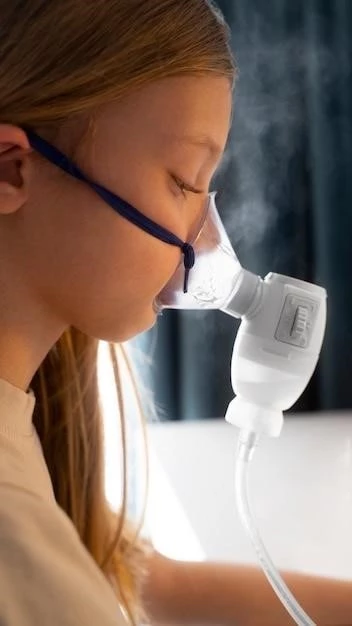Uses of Ventolin in Treating Breathing Problems
Ventolin inhaler is used to treat breathing issues like asthma and chronic obstructive pulmonary disease.
Overview of Ventolin Inhaler
The Ventolin inhaler contains albuterol‚ a bronchodilator that helps relax muscles in the airways‚ making breathing easier. It is a quick-relief medication used to treat wheezing and shortness of breath caused by respiratory conditions. The inhaler delivers the medication directly to the lungs‚ providing fast relief during asthma attacks or flare-ups of COPD symptoms.
Conditions Treated with Ventolin
Ventolin is commonly used to treat conditions such as asthma‚ chronic bronchitis‚ and emphysema. It helps in managing bronchospasm‚ which is a sudden constriction of the muscles in the airways. By opening up the air passages‚ Ventolin provides relief from symptoms like coughing‚ shortness of breath‚ and chest tightness. It is vital in controlling and preventing breathing difficulties associated with these respiratory conditions.

Side Effects of Ventolin Inhaler
Common and serious side effects may include headache‚ nervousness‚ tremors‚ rapid heartbeat‚ and chest pain.
Common Side Effects
Common side effects of Ventolin inhaler may include throat irritation‚ cough‚ nausea‚ dizziness‚ and muscle pain. These effects are usually mild and temporary‚ often diminishing as the body adjusts to the medication. It is essential to consult a healthcare provider if these symptoms persist or worsen.
Serious Side Effects
Serious side effects of Ventolin inhaler may include chest pain‚ irregular heart rhythm‚ high blood pressure‚ and worsening breathing problems. If experiencing these effects‚ immediate medical attention is necessary. Discontinue use and seek emergency help if severe allergic reactions like rash‚ itching‚ swelling‚ or difficulty breathing occur.
Precautions to Take When Using Ventolin
Adhere to proper dosage‚ avoid using excessively‚ and monitor for any adverse reactions.
Consultation with a Healthcare Provider
Before starting Ventolin‚ consult a healthcare provider to discuss medical history‚ current medications‚ and any existing health conditions. Inform the provider of allergies‚ pregnancy‚ or breastfeeding status to ensure safe and effective use of the medication.
Proper Inhaler Usage
Proper Ventolin inhaler usage involves priming the inhaler before first use‚ shaking it well‚ exhaling fully before inhaling the medication‚ and holding your breath for a few seconds to allow proper absorption. Cleaning and storing the inhaler as instructed by the healthcare provider is crucial for maintaining its effectiveness.
Drug Interactions with Ventolin
Avoid interactions by informing healthcare providers about all medications taken concurrently.
Medications that Interact with Ventolin
Medications like beta-blockers‚ diuretics‚ and MAO inhibitors may interact with Ventolin‚ potentially leading to increased heart rate‚ blood pressure changes‚ or decreased effectiveness of either medication. It is crucial to inform healthcare providers of all prescriptions‚ over-the-counter drugs‚ and supplements to prevent adverse interactions.
Potential Effects of Interactions
Interactions between Ventolin and other medications can result in increased side effects such as tremors‚ arrhythmias‚ and changes in blood glucose levels. Some interactions may reduce the effectiveness of Ventolin or the other medication‚ leading to inadequate treatment outcomes. Monitoring for adverse effects and adjusting dosages under medical supervision is crucial to mitigate risks.
Overdose Symptoms and Management of Ventolin
Recognize symptoms promptly and seek medical assistance for proper management of Ventolin overdose.
Signs of Overdose
Symptoms of Ventolin overdose may include chest pain‚ irregular heartbeat‚ tremors‚ seizures‚ and extreme nervousness. In severe cases‚ overdose can lead to life-threatening conditions. Promptly recognizing these signs and seeking medical help is crucial for appropriate intervention and management.
Steps for Managing Overdose
In case of Ventolin overdose‚ immediate medical attention is vital. Healthcare providers may administer treatments to counteract the effects‚ such as beta-blockers or seek supportive care to stabilize heart rate and blood pressure. Monitoring vital signs‚ providing oxygen support‚ and managing symptoms are essential steps in addressing Ventolin overdose. Prompt action can prevent severe complications and ensure patient safety.
Missed Dose Guidelines and Storage Recommendations for Ventolin
For missed doses‚ take it as soon as remembered unless it is close to the next dose. Store Ventolin at room temperature away from moisture and heat‚ and keep it out of reach of children.
Missed Dose Instructions
If a dose of Ventolin is missed‚ take it as soon as remembered; However‚ if it is close to the next scheduled dose‚ skip the missed dose and continue with the regular dosing schedule. Do not double the dose to make up for a missed one. Consult a healthcare provider for guidance on missed doses.
Proper Storage of Ventolin Inhaler
Store Ventolin at room temperature between 59-86°F (15-30°C) away from moisture‚ heat‚ and direct sunlight. Keep the inhaler in a dry place and protect it from freezing. Avoid storing in the bathroom. Always keep the Ventolin inhaler out of reach of children and pets.
